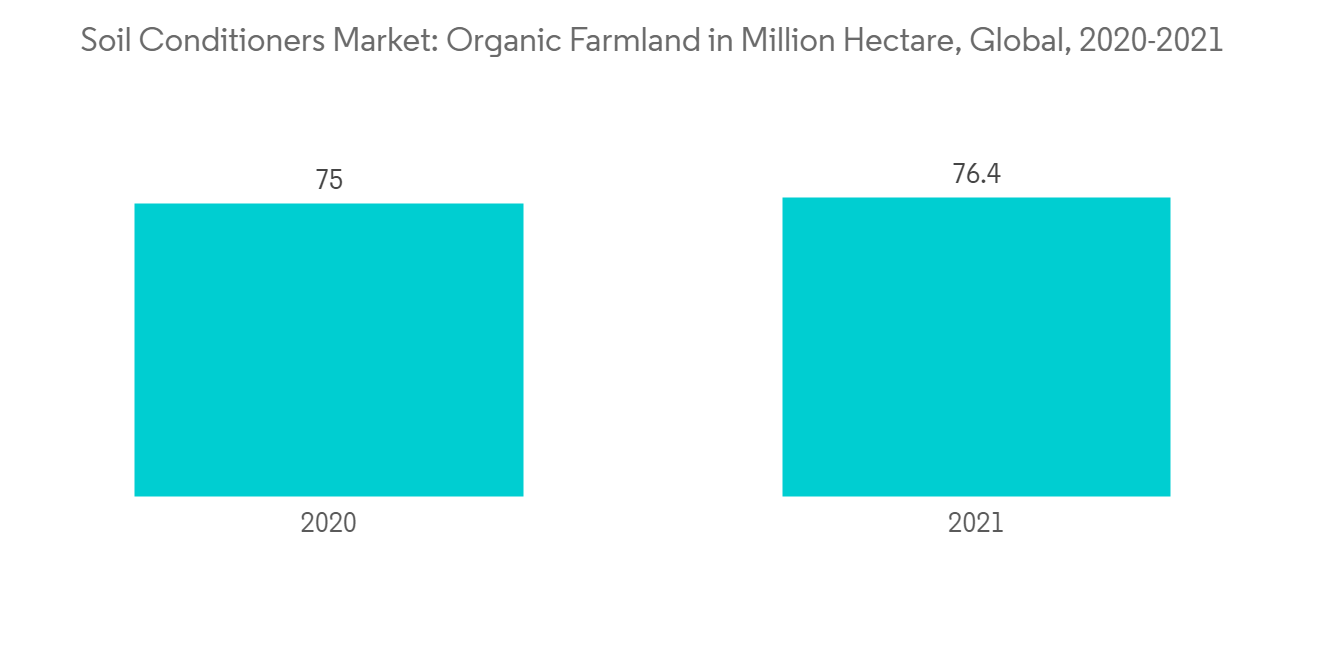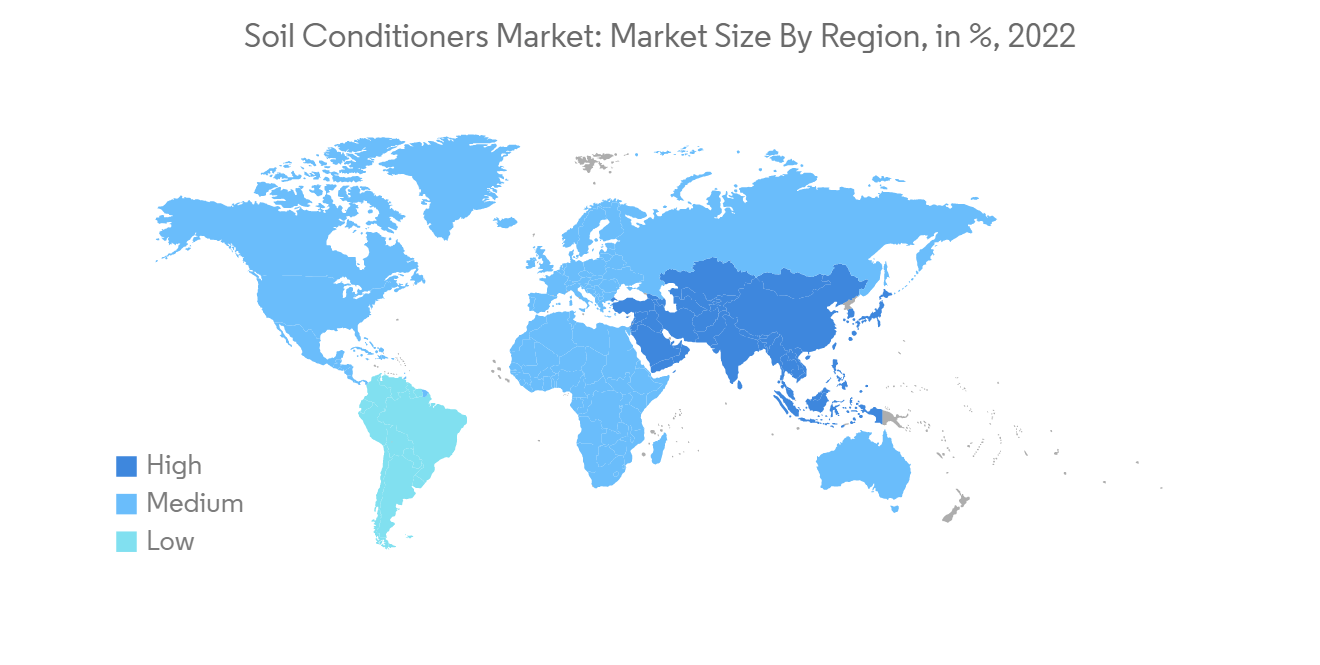PUBLISHER: Mordor Intelligence | PRODUCT CODE: 1273472

PUBLISHER: Mordor Intelligence | PRODUCT CODE: 1273472
Soil Conditioners Market - Growth, Trends, and Forecasts (2023 - 2028)
The global soil conditioners market is projected to register a CAGR of 5.8% during the forecast period.
Key Highlights
- Due to the intensive use of fertilizers, soil degradation has become a global problem, leading to the depletion of organic matter and soil fertility. Meanwhile, the intensification of agriculture accompanied by urbanization and industrialization has drastically accelerated the waste generation rate.
- For instance, coal mining produces wastes in large quantities globally, most of which end up in landfills or dump into storage dams. Accordingly, sustainable food production is driving global innovations to utilize various waste materials better to make value-added products, such as soil conditioners.
- Nowadays, soil conditioners are important in improving plant growth and soil health and reducing chemical fertilizer use. For instance, Phosphorus run-off from agriculture fields in southern Finland is the largest threat to water quality and living marine resources in this area of the Baltic Sea, and traditional farming methods have proven inadequate. So, using gypsum as a soil amendment on agricultural fields will reduce run-off pollution by 50%, decrease demand for virgin-mined phosphorus, and reuse industrial waste. This will encourage the growth of the market in the coming years.
- Soil management is an increasingly important global issue. According to Food and Agriculture Organization (FAO), 38% of global soil has been degraded, which causes the loss of soil organic matter, salinity, acidity, or alkalinity, and a decline in fertility. The degradation of soil conditions and structure, the need for food security, and enhanced nutrient management in the soil are some factors driving the market growth for soil conditioners in the coming years.
Soil Conditioners Market Trends
Degradation of Soil Condition and Soil Structure
- According to the Food and Agriculture Organization (FAO), the land equipped for irrigation is expected to expand by 32.0 million hectares, while harvested irrigated land is expected to expand by 17.0% by 2050. These scenarios are expected to be witnessed in developing countries, resulting in insufficient crop nutrient supply.
- According to a United Nations estimate, about 1.9 billion hectares of land have lost productivity, and 2 billion people are affected by land degradation globally. If land degradation continues at this pace, 95% of the Earth's land areas will be degraded by 2050. Thus, this leads to a lower yield of crops, along with a decline in the quality of the final product.
- The growing population worldwide is resulting in a decline in the proportion of arable land primarily used to produce food. This necessitates cultivation in poor soils. Soil degradation, directly and indirectly, affects agricultural productivity and water quality due to the increase in soil erosion, overgrazing, and other human-induced activities, such as deforestation, mining, industrial development, etc. Increasing soil conditioners and irrigation use efficiencies address the input side of the equation to the soil condition, which has been driving the market for soil conditioners in recent times.
- Farmers worldwide use soil conditioners, such as green manure, compost, etc., to recover soil fertility and address the soil structure so that it helps the plants take up nutrients and water efficiently. According to the Research Institute of Organic Agriculture (German: Forschungsinstitut fur biologischen Landbau) (FiBL), the global organic farmland had increased by 76.4 million hectares in 2021 compared to the previous year. Companies in the market are introducing new products to cater to the farmers' demands for improving soil conditions and structure.

Asia Pacific Dominates the Market
- Asia-Pacific is considered to be one of the largest markets for agricultural products due to its large fertile lands and favorable climatic conditions. Despite these favorable conditions, the region is witnessing severe soil degradation due to frequent cropping to meet the food demand. In such a scenario, soil conditioners, such as compost, play an important role as a replacement or supplement for chemical fertilizers in replenishing nutrient-depleted soil.
- In countries like India, organic manure, including farmyard manure and green manure, is the oldest and most widely practiced means of nutrient replenishment for plants. As per a report by the Food and Agriculture Organization (FAO), due to the high animal population in India, farmyard manure is the most common organic manure, with cattle accounting for 90% of the total manure production in the country.
- A rise in soil erosion rates, land clearance, deforestation, etc., have induced farmers to rely on soil conditioners to improve yields and soil health to address the growing food demand of the ever-increasing population in the region. Especially for markets like China, with excessive chemical fertilizers and pesticides applied to intensive cultivation, the soil has degraded mainly in the past decades. Now growers demand effective solutions to their specific soil problems. Major producers are investing in R&D to innovate new product lines to solve the problems related to the soil to make the region sustainable without causing any loss in the production of agricultural crops. Thus, this is expected to drive the market for soil conditioners in the future.

Soil Conditioners Industry Overview
The market is highly fragmented, with the presence of many local and international players operating in the market. UPL Limited, Saint-Gobain Group, Omnia Holdings Limited, Evonik Industries AG, and Sanoway GmbH are some of the prominent players who are operating in the market. These players are innovating new products that cater to the needs of growers across various regions. These companies are not only competing on the basis of product quality or product promotion but are also focused on other strategic moves, like acquisitions and expansions, to acquire a larger share and expand their acquired market size.
Additional Benefits:
- The market estimate (ME) sheet in Excel format
- 3 months of analyst support
TABLE OF CONTENTS
1 INTRODUCTION
- 1.1 Study Assumptions and Market Definition
- 1.2 Scope of the Study
2 RESEARCH METHODOLOGY
3 EXECUTIVE SUMMARY
4 MARKET DYNAMICS
- 4.1 Market Overview
- 4.2 Market Drivers
- 4.3 Market Restraints
- 4.4 Porter's Five Forces Analysis
- 4.4.1 Bargaining Power of Buyers
- 4.4.2 Bargaining Power of Suppliers
- 4.4.3 Threat of New Entrants
- 4.4.4 Threat of Substitute Products
- 4.4.5 Intensity of Competitive Rivalry
5 MARKET SEGMENTATION
- 5.1 Product Type
- 5.1.1 Organic
- 5.1.1.1 Compost
- 5.1.1.2 Green and Farmyard Manure
- 5.1.1.3 Peat
- 5.1.1.4 Other Organic Types
- 5.1.2 Inorganic
- 5.1.2.1 Polymers
- 5.1.2.2 Gypsum
- 5.1.1 Organic
- 5.2 Geography
- 5.2.1 North America
- 5.2.1.1 United States
- 5.2.1.2 Canada
- 5.2.1.3 Mexico
- 5.2.1.4 Rest of North America
- 5.2.2 Europe
- 5.2.2.1 Spain
- 5.2.2.2 United Kingdom
- 5.2.2.3 France
- 5.2.2.4 Germany
- 5.2.2.5 Italy
- 5.2.2.6 Russia
- 5.2.2.7 Rest of Europe
- 5.2.3 Asia Pacific
- 5.2.3.1 China
- 5.2.3.2 India
- 5.2.3.3 Japan
- 5.2.3.4 Australia
- 5.2.3.5 Rest of Asia Pacific
- 5.2.4 South America
- 5.2.4.1 Brazil
- 5.2.4.2 Argentina
- 5.2.4.3 Rest of South America
- 5.2.5 Africa
- 5.2.5.1 South Africa
- 5.2.5.2 Rest of Africa
- 5.2.1 North America
6 COMPETITIVE LANDSCAPE
- 6.1 Most Adopted Strategies
- 6.2 Market Share Analysis
- 6.3 Company Profiles
- 6.3.1 UPL Limited
- 6.3.2 Southern Petrochemical Industries Corporation Ltd (SPIC)
- 6.3.3 Saint-Gobain Group
- 6.3.4 Omnia Holdings Limited
- 6.3.5 Sanoway GmbH
- 6.3.6 Evonik Industries AG
- 6.3.7 Mangalore Chemicals & Fertilizers Limited
7 MARKET OPPORTUNITIES AND FUTURE TRENDS




